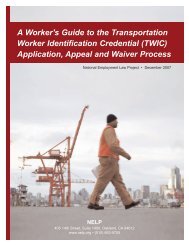Rebuilding Lives. Strengthening Communities.
Rebuilding Lives. Strengthening Communities.
Rebuilding Lives. Strengthening Communities.
You also want an ePaper? Increase the reach of your titles
YUMPU automatically turns print PDFs into web optimized ePapers that Google loves.
Expand capacity and number of Adult Transition Centers for a more<br />
gradual transition from prison to the community.<br />
Recommendation<br />
Issue<br />
For most prisoners, the transition from prison back to<br />
their communities is a stressful and complicated time,<br />
filled with questions, concerns and unknowns.<br />
With even the best pre-release programming, many<br />
prisoners may not be mentally, emotionally or logistically<br />
prepared for their discharge. The Illinois Department of<br />
Corrections (IDOC) has created Adult Transition Centers<br />
(ATCs) to provide selected prisoners with structured<br />
supervision in a community setting for a more gradual<br />
transition back into society. Formerly known as<br />
Community Corrections Centers or Work Release Centers,<br />
the ATCs allow incarcerated individuals to spend the last<br />
months of their sentence residing in or near their home<br />
community. They have been successful in helping prisoners<br />
reconnect with family, prepare for the rigors of employment,<br />
and generally readjust to the social and cultural<br />
mores of life outside prison. 30<br />
IDOC operates eight ATCs throughout the state, three of<br />
which are located in Chicago. 31 Only one of these eight<br />
centers houses female prisoners. All combined, they are<br />
designed to house approximately 1,500 prisoners, who<br />
must work or go to school and return to the ATC when<br />
not participating in an approved community activity.<br />
Prisoners who are within two years of release and<br />
classified as minimum security may apply for transfer to<br />
an ATC, and IDOC is extremely selective about who is<br />
approved. The population at ATCs has increased 22 percent<br />
in recent years from 1,360 in 1999 to 1,658 in 2001. 32<br />
Despite this increase, only three percent of all Illinois prisoners<br />
are transferred to Adult Transition Centers.<br />
Prisoners at ATCs are expected to spend at least 35 hours<br />
a week involved in constructive activity, including<br />
employment, vocational training, life skills, alcohol and<br />
drug counseling and public service work. These individuals<br />
are expected to contribute 20–30 percent of their<br />
income to offset the facilities’ operation costs, and are<br />
required to save a portion of their earnings. This financial<br />
involvement helps prisoners develop a sense of personal<br />
responsibility and competency. Those individuals unwilling<br />
or unable to live up to the requirements of the ATC are<br />
returned to prison to serve out the remainder of their<br />
sentence.<br />
Unfortunately, even with highly restrictive requirements<br />
for participation, these ATCs operate beyond full capacity,<br />
and can only accommodate and assist a small portion of<br />
the prison population to gradually transition back into<br />
their communities.<br />
MAYORAL POLICY CAUCUS ON PRISONER REENTRY<br />
89
















